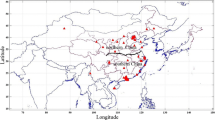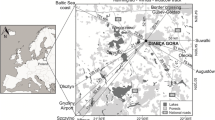Abstract
The results of a back-trajectory analysis of 9-year (2013–2021) measurements of organic (OC) and elemental (EC) aerosol carbon concentrations made at the atmospheric monitoring station near St. Petersburg (Peterhof, 59.88° N, 29.83° E) are presented. The spatial location of sources was estimated by the concentration weighted trajectory (CWT) method in the geographic area 16°–44° E × 48°–68° N. The data allow us to identify the territories with the strongest OC and EC emissions and estimate the seasonal variability of these emissions. In particular, the estimates show that the most intense sources of OC and elemental aerosol carbon in the studied region are located in the Volga-Oka interfluve and on the adjacent territories. It is demonstrated that linear regression coefficients between CWT function values for OC and EC differ for different regions and seasons and may indicate the prevailing type of sources of carbon-containing aerosol particles.




Similar content being viewed by others
REFERENCES
Andreae, M.O. and Merlet, P., Emission of trace gases and aerosols from biomass burning, Global Biogeochem. Cycles, 2001, vol. 15, pp. 955–966.
Andreae, M.O., Aerosols before pollution, Science, 2007, vol. 315, pp. 50–51.
Andreae, M.O. and Rosenfeld, D., Aerosol–cloud–precipitation interactions. Part 1. The nature and sources of cloud-active aerosols, Earth-Sci. Rev., 2008, vol. 89, pp. 13–41.
Birch, M.E., Analysis of carbonaceous aerosols: Interlaboratory comparison, Analyst, 1998, vol. 123, no. 5, pp. 851–857.
Birch, M.E. and Cary, R.A., Elemental carbon-based method for monitoring occupational exposures to particulate diesel exhaust, Aerosol Sci. Technol., 1996, vol. 25, no. 3, pp. 221–241.
Bond, T.C., Streets, D.G., Yaber, K.F., Nelson, S.M., Woo, J., and Klimont, Z., A technology-based global inventory of black and organic carbon emissions from combustion, J. Geophys. Res., 2004, vol. 109, p. D14203. https://doi.org/10.1029/2003JD003697
Byčenkienė, S., Dudoitis, V., and Ulevicius, V., The use of trajectory cluster analysis to evaluate the long-range transport of black carbon aerosol in the south-eastern Baltic region, Adv. Meteorol., 2014, p. 137694. https://doi.org/10.1155/2014/137694
Cao, J.J., Zhu, C.S., Tie, X.X., Geng, F.H., Xu, H.M., Ho, S.S., Wang, G.H., Han, Y.M., and Ho, K.F., Characteristics and sources of carbonaceous aerosols from Shanghai, China, Atmos. Chem. Phys., 2013, vol. 13, no. 2, pp. 803–817.
Carslaw, K.S., Lee, L.A., Reddington, C.L., Pringle, K.J., Rap, A., Forster, P.M., Mann, G.W., Spracklen, D.V., Woodhouse, M.T., Regayre, L.A., and Pierce, J.R., Large contribution of natural aerosols to uncertainty in indirect forcing, Nature, 2013, vol. 503, no. 7, pp. 67–71.
Cassol, H.L.G., Domingues, L.G., Sanchez, A.H., Basso, L.S., Marani, L., Tejada, G., Alden, C.B., Miller, J.B., Gloor, M., Anderson, L.O., Aragao, L.E., and Gatti, L.V., Determination of region of influence obtained by aircraft vertical profiles using the density of trajectories from the HYSPLIT model, Atmosphere, 2020, vol. 11, no. 10, p. 1073.
Chi, X., Winderlich, J., Mayer, J.C., Panov, A.V., Heimann, M., Birmili, W., Heintzenberg, J., Cheng, Y., and Andreae, M.O., Long-term measurements of aerosol and carbon monoxide at the Zotto tall tower to characterize polluted and pristine air in the Siberian taiga, Atmos. Chem. Phys., 2013, vol. 13, pp. 12271–12298.
Chung, S.H. and Seinfeld, J.H., Climate response of direct radiative forcing of anthropogenic black carbon, J. Geophys. Res., 2005, vol. 110, p. D11102. https://doi.org/10.1029/2004JD005441
Draxler, R.R. and Hess, G.D., An overview of the HYSP-LIT_4 modeling system for trajectories, dispersion, and deposition, Aust. Meteorol. Mag., 1998, vol. 47, no. 4, pp. 295–308.
Dusek, U., Hitzenberger, R., Kasper-Giebl, A., Kistler, M., Meijer, H.A.J., Szidat, S., Wacker, L., Holzinger, R., and Röckmann, T., Sources and formation mechanisms of carbonaceous aerosol at a regional background site in the Netherlands: Insights from a year-long radiocarbon study, Atmos. Chem. Phys., 2017, vol. 17, pp. 3233–3251.
Forster, P., Ramaswamy, V., Artaxo, P., Berntsen, T., Betts, R., Fahey, D.W., Haywood, J., Lean, J., Lowe, D.C., Myhre, G., Nganga, J., Prinn, R., Raga, G., Schulz, M., and Van Dorland, R., Changes in atmospheric constituents and in radiative forcing, in Climate Change 2007: The Physical Science Basis. Contribution of Working Group I to the Fourth Assessment Report of the Intergovernmental Panel on Climate Change, Solomon, S., Qin, D., Manning, M., , Eds., Cambridge: Cambridge Univ. Press, 2007, pp. 129–234.
Giemsa, E., Jacobeit, J., Ries, L., and Hachinger, S., Investigating regional source and sink patterns of alpine CO2 and CH4 concentrations based on a back trajectory receptor model, Environ. Sci. Eur., 2019, vol. 31. https://doi.org/10.1186/s12302-019-0233-x
Grivas, G., Cheristandis, S., and Chaloulakou, A., Elemental and organic carbon in the urban environment of Athens: Seasonal and diurnal variations and estimates of secondary organic carbon, Sci. Total Environ., 2012, vol. 414, no. 1, pp. 535–545.
Gulev, S.K., Thorne, P.W., Ahn, J., Dentener, F.J., Domingues, C.M., Gerland, S., Gong, D., Kaufman, D.S., Nnamchi, H.C., Quaas, J., Rivera, J.A., Sathyendranath, S., Smith, S.L., Trewin, B., Schuckmann, K., and Vose, R.S., Changing state of the climate system, in Climate Change 21: The Physical Science Basis. Contribution of Working Group I to the Sixth Assessment Report of the Intergovernmental Panel on Climate Change, Masson-Delmotte, V., Zhai, P., Pirani, A., et al., Eds., Cambridge: Cambridge University Press, 2021, pp. 287–422. https://doi.org/10.1017/9781009157896.004.
Hao, T., Cai, Z., Chen, S., Han, S., Yao, Q., and Fan, W., Transport pathways and potential source regions of PM2.5 on the west coast of Bohai Bay during 2009–2018, Atmosphere, 2019, vol. 10, p. 345.
Ho, K.F., Lee, S.C., Cao, J.J., Li, Y.S., Chow, J.C., Watson, J.G., and Fung, K., Variability of organic and elemental carbon, water soluble organic carbon, and isotopes in Hong Kong, Atmos. Chem. Phys., 2006, vol. 6, pp. 4569–4576.
Hopke, P.K., Recent developments in receptor modeling, J. Chemom., 2003, vol. 17, pp. 255–265.
Ito, A. and Penner, J.E., Historical emissions of carbonaceous aerosols from biomass and fossil fuel burning for the period 1870–2000, Global Biogeochem. Cycles, 2005, vol. 19, no. 2, p. GB2028. https://doi.org/10.1029/2004GB002374
Kanakidou, M., Seinfeld, J.H., Pandis, S.N., Barnes, I., Dentener, F.J., Facchini, M.C., Van Dingenen, R., Ervens, B., Nenes, A., Nielsen, C.J., Swietlicki, E., Putaud, J.P., Balkanski, Y., Fuzzi, S., Horth, J., et al., Organic aerosol and global climate modelling: a review, Atmos. Chem. Phys., 2005, vol. 5, pp. 1053–1123.
Kim, E. and Hopke, P.K., Improving source identification of fine particles in a rural northeastern U.S. area utilizing temperature-resolved carbon fractions, J. Geophys. Res., 2004, vol. 109, p. D09204. https://doi.org/10.1029/2003JD004199
Kondo, Y., Komazaki, Y., Miyazaki, Y., Moteki, N., Takegawa, N., Kodama, D., Deguchi, S., Nogami, M., Fukuda, M., Miyakawa, T., Morino, Y., Koike, M., Sakurai, H., and Ehara, K., Temporal variations of elemental carbon in Tokyo, J. Geophys. Res., 2006, vol. 111, p. D12205. https://doi.org/10.1029/2005JD006257
Levin, Z. and Cotton, W.R., Aerosol Pollution Impact on Precipitation. A Scientific Review, Dordrecht: Springer Science, 2009.
Mikhailov, E.F., Mironova, S.Yu., Makarova, M.V., Vlasenko, S.S., Ryshkevich, T.I., Panov, A.V., and Andreae, M.O., Studying seasonal variations in carbonaceous aerosol particles in the atmosphere over central Siberia, Izv., Atmos. Ocean. Phys., 2015, vol. 51, no. 4, pp. 423–430.
Mikhailov, E.F., Mironova, S., Mironov, G., Vlasenko, S., Panov, A., Chi, X., Walter, D., Carbone, S., Artaxo, P., Heimann, M., Lavric, J., Pöschl, U., and Andreae, M.O., Long-term measurements (2010–2014) of carbonaceous aerosol and carbon monoxide at the Zotino Tall Tower Observatory (ZOTTO) in central Siberia, Atmos. Chem. Phys., 2017, vol. 17, pp. 14365–14392.
Pekney, N.J., Davidson, C.I., Zhou, L., and Hopke, P.K., Application of PSCF and CPF to PMF-modeled sources of PM2.5 in Pittsburgh, Aerosol Sci. Technol., 2006, vol. 40, pp. 952–961.
Popova, S.A. and Makarov, V.I., Determination of secondary organic carbon concentrations in continental aerosols, Geo-Sibir’, 2009, vol. 4, no. 2, pp. 57–60.
Ruckstuhl, A.F., Jacobson, M.P., Field, R.W., and Dodd, J.A., Baseline subtraction using robust local regression estimation, J. Quant. Spectrosc. Radiat. Transfer, 2001, vol. 68, pp. 179–193.
Ruckstuhl, A.F., Henne, S., Reimann, S., Steinbacher, M., Vollmer, M.K., O’Doherty, S., Buchmann, B., and Hueglin, C., Robust extraction of baseline signal of atmospheric trace species using local regression, Atmos. Meas. Tech., 2012, vol. 5, no. 11, pp. 2613–2624.
Safatov, A.S., Buryak, G.A., Olkin, S.E., Reznikova, I.K., Makarov, V.I., and Popova, S.A., Analysis of monitoring data on organic/elemental carbon and total protein in ground air layer aerosol in the south of Western Siberia, Atmos. Oceanic Opt., 2014, vol. 27, no. 2, pp. 164–168.
Singh, A., Rajput, P., Sharma, D., Sarin, M.M., and Singh, D., Black carbon and elemental carbon from postharvest agricultural-waste burning emissions in the Indo-Gangetic plain, Adv. Meteorol., 2014, vol. 2014, p. 179301.
Stein, A.F., Draxler, R.R., Rolph, G.D., Stunder, B.J.B., Cohen, M.D., and Ngan, F., NOAA’s HYSPLIT atmospheric transport and dispersion modeling system, Bull. Am. Meteorol. Soc., 2015, vol. 96, pp. 2059–2077.
Vlasenko, S.S., Volkova, K.A., Ionov, D.V., Ryshkevich, T.I., Ivanova, O.A., and Mikhailov, E.F., Variation of carboneceous atmospheric aerosol near St. Petersburg, Izv., Atmos. Ocean. Phys., 2019, vol. 55, no. 6, pp. 619–627.
Volkova, K.A., Anikin, S.S., Mikhailov, E.F., Ionov, D.V., Vlasenko, S.S., and Ryshkevich, T.I., Seasonal and daily variability of aerosol particle concentrations near St. Petersburg, Atmos. Oceanic Opt., 2020, vol. 33, no. 5, pp. 524–530.
Wang, Yu., Wang, X., Kondo, Y., Kajino, M., Munger, J.W., and Hao, J.M., Black carbon and its correlation with trace gases at a rural site in Beijing: Top-down constraints from ambient measurements on bottom-up emissions, J. Geophys. Res., 2011, vol. 116, p. D24304.
Wang, Yu., Anan, Yu., Le Yang, L., and Fang, C., Research on organic carbon and elemental carbon distribution characteristics and their influence on fine particulate matter (PM2.5) in Changchun city, Environments, 2019, vol. 6, no. 2, pp. 2–9.
Yan, R., Yu, S., Zhang, Q., Li, P., Wang, S., Chen, B., and Liu, W., A heavy haze episode in Beijing in February of 2014: Characteristics, origins and implications, Atmos. Pollut. Res., 2015, vol. 6, pp. 867–876.
Zachary, M., Yin, L., and Zacharia, M., Application of PSCF and CWT to identify potential sources of aerosol optical depth in ICIPE Mbita, Open Access Lib. J., 2018, vol. 5, no. 4, pp. 1–12. https://doi.org/10.4236/oalib.1104487
Zhang, F., Zhou, L.X., Novell, P.C., Worthy, D.E.J., Zellweger, C., Klausen, J., Ernst, M., Steinbacher, M., Cai, Y.X., Xu, L., Fang, S.X., and Yao, B., Evaluation of in situ measurements of atmospheric carbon monoxide at Mount Waliguan, China, Atmos. Chem. Phys., 2011, vol. 11, pp. 5195–5206.
Zhou, L., Hopke, P.K., and Liu, W., Comparison of two trajectory based models for locating particle sources for two rural New York sites, Atmos. Environ., 2004, vol. 38, pp. 1955–1963.
Funding
This work was carried out using equipment of the St. Petersburg State University Geomodel resource center at the St. Petersburg State University scientific park and supported by the Russian Science Foundation, project 22-27-00258.
Author information
Authors and Affiliations
Corresponding author
Ethics declarations
The authors of this work declare that they have no conflicts of interest.
Additional information
Publisher’s Note.
Pleiades Publishing remains neutral with regard to jurisdictional claims in published maps and institutional affiliations.
Rights and permissions
About this article
Cite this article
Vlasenko, S.S., Ivanova, O.A., Ryshkevich, T.I. et al. Estimation of Spatial Distribution of Potential Sources of Carbonaceous Aerosol from Local Measurements near St. Petersburg. Izv. Atmos. Ocean. Phys. 59, 685–694 (2023). https://doi.org/10.1134/S0001433823060129
Received:
Revised:
Accepted:
Published:
Issue Date:
DOI: https://doi.org/10.1134/S0001433823060129




